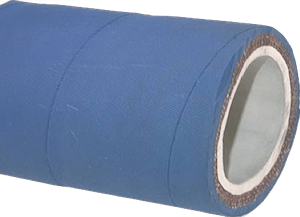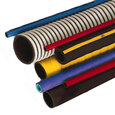Hosing and Tubing Materials
Hoses and tubes can be manufactured from a diverse range of materials or combinations of materials, allowing their use across various industries. A crucial factor for the hose material is its chemical resistance to the substances that will pass through it. For typical materials, you can refer to our chemical resistance chart to check if the hose material is appropriate for a specific application. In this article, we will explore the common material choices.
Table of contents
Buy Hoses & Tubes Online Today!
Plastics
Plastics are materials made from synthetic or semi-synthetic organic molecules called polymers. In addition to these polymers, most plastics contain plasticizers and filling compounds to change the properties of the plastic. In general they are mold-able and can be transformed to the desired shape. Well known plastics are PVC, PP and PFFE. For pneumatic applications, plastics is often the chosen material and is further discussed in a pneumatic hose article. The most commonly used plastics in hoses are discussed below.
-
Polyurethane (PUR or PU)
- PU is the most common pneumatic tubing material as it has very good kink and abrasion resistance while being durable. It is typically rated for working pressures of 10 bar and higher. It also has good elastic memory, making it well suited for coiled, portable, and self-storing hose applications.
-
Polyamide (PA or Nylon)
- Nylon is a harder plastic than PU and is light, robust, dimensionally stable, and has excellent chemical resistance. It is less flexible than PU, but still has a good bend radius making it suitable for air distribution and applications with straight lines. For a standard 4x2 tube, it can handle up to 44 bar and temperatures up to 100°C. Nylon has good flexural-fatigue resistance and a low moisture absorption rate.
-
Polypropylene (PP)
- PP is very light and can even float on water. It has a very good chemical resistance to media like chlorinated water and acids. It has good surface hardness, dimensional stability, and electrical properties making it resistant against environmental stress cracking. It can handle higher temperatures and pressures when compared to PU.
-
Polyvinylchloride (PVC)
- Flexible PVC is often used for food-grade applications and is also a cost-effective solution. It is more flexible than PE and Nylon, but loses some durability compared to PU. PVC has a very good chemical resistance to media like chlorinated water and acids. It is also clear, making it suitable for applications that demand a visual flow indication.
-
Polytetrafluoroethylene (PTFE or Teflon)
- PTFE is a very versatile hose material due to it’s outstanding chemical resistance making it almost chemically inert. It typically has a large temperature range of -196°C up to 260°C and is a dielectric (strong insulator) making it suitable for applications sensitive to static electricity.
-
Perfluoroalkoxy (PFA)
- PFA is a fluoropolymer like PTFE, making it very versatile due to it’s chemical resistance and being a dielectric. The main difference between PFA and PTFE is that PFA is melt-processed.
-
Polyethylene (PE)
- PE is a harder plastic compared to PU and its characteristics are similar to those of Nylon. PE is light, floats on water, flexible, and is a relatively cost-effective solution. It is typically used for low-pressure pneumatic systems and for pneumatic controls. A variation of PE is HDPE, which is more rigid, has a higher pressure rating, and is more durable.
Rubbers
Common rubber materials are latex, nitrile rubber (NBR), and ethylene propylene diene monomer (EPDM). Rubbers (especially latex) are flexible and have good elastic memory. Rubbers are characterized by their non-deforming elasticity and high chemical and heat resistance. The most commonly used rubbers in hoses are discussed below.
-
Styrene butadiene (SBR) rubbers
- Styrene butadiene rubbers are a group of synthetic rubbers made from the monomers styrene and butadiene. The mixtures of these monomers is polymerized through one of two processes, solution or emulsion polymerization. The ratio of styrene and butadiene influences the properties of the rubber; a higher styrene content makes the rubber harder and less flexible. SBR rubbers are mainly used in gas and hydraulic applications.
-
Acrylonitrile butadiene (nitrile) rubber
- Acrylonitrile butadiene rubber is a synthetic rubber made from acrylonitrile and butadiene in various ratios. An important determining factor for the properties of nitrile rubber is the ratio between the two monomers. Lower acrylonitrile contents give rise to lower glass transitions temperatures (brittleness temperature) while higher acrylonitrile contents result in a better chemical resistance. Most commercially available nitrile rubbers contain 33% acrylonitrile.
-
Ethylene propylene (EPM/EPR) rubber
- Ethylene propylene rubbers are a group of synthetic rubbers made with various ratios of ethylene and propylene. It is a relatively flexible rubber compared to SBR. EPM rubbers have a very high electrical resistance, making them perfect for insulation use. Vulcanizing EPM rubbers makes them resistant to high temperatures (up to 160 °C). In general EPM rubbers are UV, ozone and weather resistant.
-
Ethylene propylene diene (EPDM) rubber
- Ethylene propylene diene rubbers are synthetic rubbers made from the three previously mentioned monomers. These rubbers have a chemically saturated backbone, giving them outstanding resistance to heat, ozone, UV and weather. Like all synthetic rubbers, the physical properties of EPDM depend on the ratios of monomers in the rubber, and the degree of vulcanization. In general, EPMDM is resistant to polar chemicals like hydraulic fluids, ketones, water and acids/alkalis but not resistant to oils, gasoline and other fuels.
Silicone
Silicone is often considered a rubber, but it is actually a hybrid between a plastic and a rubber. It has many properties of both. From a plastic standpoint, it is flexible, temperature and water resistance, clarity, and is moldable allowing it to be shaped, formed, softened, or hardened. However, silicone has better characteristics than most plastics due to its chemical resistance, higher temperature rating, durability, and weather resistance.
Reinforced hoses & tubes
Typically, hoses/tubes are considered ‘monolayer’, meaning they consist of one single material. However, hoses and tubes can be constructed using several layers of materials in order to have their characteristics complement each other. This is called ‘structured’ or ‘reinforced’ hoses and tubes. For example, a flexible PVC hose can be reinforced with textile braiding or knitting around the inner layer of the hose to increase the pressure rating.
Basic reinforced hoses or tubes consist of three general layers:
- Inner tube: Material is chosen due to its resistance to the media
- Reinforcement: To increase ratings, such as pressure or buckling resistance.
- Outer protection layer: Increases durability and damage from the environment.
The actual reinforcement and combination of these materials is typically done by:
- Textile braiding or knitting
- Metal wire braiding
- Wire reinforcement
- Spiral reinforcement
- Impregnated mesh braiding
- Interior liner
- Combination of the above methods
Selection criteria
Besides material, it is also important to properly size your hose from a length and diameter perspective. Read our article on tubing and hosing selection criteria for an overview.






